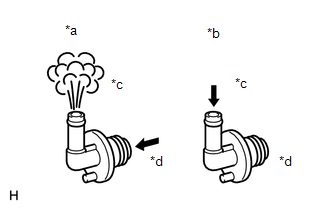Toyota Yaris: Brake Booster / Inspection
INSPECTION
PROCEDURE
1. INSPECT BRAKE VACUUM CHECK VALVE ASSEMBLY
| (a) Check that there is ventilation from the booster side to the engine side, and no ventilation from the engine side to the booster side of the brake vacuum check valve assembly. HINT: If the result is not as specified, replace the brake vacuum check valve assembly. |
|
 Removal
Removal
REMOVAL CAUTION / NOTICE / HINT The necessary procedures (adjustment, calibration, initialization or registration) that must be performed after parts are removed and installed, or replaced during brake booster assembly removal/installation are shown below...
 Reassembly
Reassembly
REASSEMBLY PROCEDURE 1. INSTALL VACUUM SENSOR ASSEMBLY (a) Install a new vacuum sensor grommet to the brake booster assembly. (b) Install the vacuum sensor assembly to the brake booster assembly as shown in the illustration...
Other information:
Toyota Yaris XP210 (2020-2025) Owner's Manual: Emission Control System
This vehicle is equipped with an emission control system (the catalytic converter is part of this system) that enables the vehicle to comply with existing exhaust emissions requirements. Under U.S. federal law, any modification to the original-equipment emission control system before the first sale and registration of a vehicle is subject to penalties...
Toyota Yaris XP210 (2020-2025) Reapir and Service Manual: Window Defogger Wire
On-vehicle InspectionON-VEHICLE INSPECTION PROCEDURE 1. INSPECT DEFOGGER WIRE (BACK DOOR GLASS) NOTICE: When cleaning the glass, wipe the glass along the wire using a soft, dry cloth. Take care not to damage the defogger wires. Do not use detergents or glass cleaners that have abrasive ingredients...
Categories
- Manuals Home
- Toyota Yaris Owners Manual
- Toyota Yaris Service Manual
- Battery Monitor Module General Electrical Failure (P058A01)
- Fuse Panel Description
- Maintenance
- New on site
- Most important about car
Break-In Period
No special break-in is necessary, but a few precautions in the first 600 miles (1,000 km) may add to the performance, economy, and life of the vehicle.
Do not race the engine. Do not maintain one constant speed, either slow or fast, for a long period of time. Do not drive constantly at full-throttle or high engine rpm for extended periods of time. Avoid unnecessary hard stops. Avoid full-throttle starts.
Copyright © 2025 www.toyaris4.com

